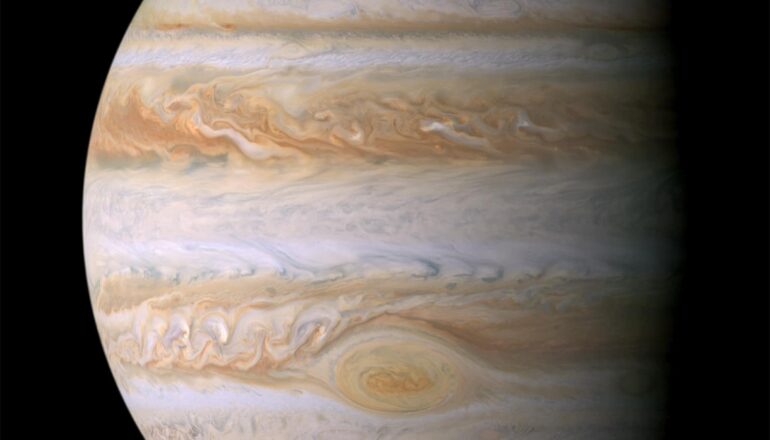Jupiter may have reshaped our solar system in dramatic ways
- Jupiter’s rapid early growth may have reshaped our solar system in dramatic ways, carving out rings and gaps that explain why many primitive meteorites formed millions of years after the first solid bodies.
- The study suggests that Jupiter’s immense gravity created “cosmic traffic jams” in the sun’s surrounding disk of gas and dust, preventing small particles from spiraling into the sun and allowing them to collect into dense bands where they could clump together into planetesimals.
- These planetesimals represent a second generation of building blocks, born later in the system’s history, and are preserved in chondrites—a family of stony meteorites that provide clues about our cosmic origins.
- The study also helps explain why Earth, Venus, and Mars are clustered around 1 astronomical unit from the sun rather than spiraling inward as happens in many extrasolar planetary systems, due to Jupiter’s suppression of gas material toward the inner solar system.
- Without Jupiter, we might not have Earth as we know it, and its early growth left a signature that can still be read today, locked inside meteorites that fall to Earth, providing a unique window into our solar system’s history.

New research suggests that the giant planet Jupiter reshaped the early solar system in dramatic ways.
The work indicates Jupiter carved out rings and gaps that ultimately explain one of the longest-standing puzzles in planetary science: why many primitive meteorites formed millions of years after the first solid bodies.
“Without [Jupiter], we might not have Earth as we know it.”
The study, which combined hydrodynamic models of Jupiter’s growth with simulations of dust evolution and planet formation, appears in Science Advances.
Through state-of-the-art computer simulations, planetary scientists André Izidoro and Baibhav Srivastava found that Jupiter’s rapid early growth destabilized the sun’s surrounding disk of gas and dust. The planet’s immense gravity sent ripples through the newborn solar system’s disk, creating “cosmic traffic jams” that prevented small particles from spiraling into the sun. Instead, these particles collected into dense bands where they could clump together into planetesimals—the rocky seeds of planets.
The surprising twist is that the planetesimals formed in these bands were not the solar system’s original building blocks. Instead, they represent a second generation, born later in the system’s history. Their birth coincides with that of many chondrites—a family of stony meteorites that preserve chemical and chronological clues from the solar system’s infancy.
“Chondrites are like time capsules from the dawn of the solar system,” says Izidoro, assistant professor of Earth, environmental, and planetary sciences at Rice University.
“They have fallen to Earth over billions of years, where scientists collect and study them to unlock clues about our cosmic origins. The mystery has always been: Why did some of these meteorites form so late, 2 to 3 million years after the first solids? Our results show that Jupiter itself created the conditions for their delayed birth.”
Chondrites are especially significant because they are some of the most primitive materials available to science. Unlike meteorites from the first generation of building blocks—which melted, differentiated and lost their original character—chondrites preserve pristine solar system dust and tiny molten droplets called chondrules. Their late formation has puzzled scientists for decades.
“Our model ties together two things that didn’t seem to fit before—the isotopic fingerprints in meteorites, which come in two flavors, and the dynamics of planet formation,” says Srivastava, a graduate student working in Izidoro’s lab.
“Jupiter grew early, opened a gap in the gas disk, and that process protected the separation between inner and outer solar system material, preserving their distinct isotopic signatures. It also created new regions where planetesimals could form much later.”
The study also helps explain another solar system mystery: why Earth, Venus, and Mars are clustered around 1 astronomical unit from the sun rather than spiraling inward as happens in many extrasolar planetary systems. Jupiter cut off the flow of gas material toward the inner solar system, suppressing the inward migration of young planets. Instead of plunging toward the sun, these growing worlds remained trapped in the terrestrial region, where Earth and its neighbors eventually formed.
“Jupiter didn’t just become the biggest planet—it set the architecture for the whole inner solar system,” Izidoro says. “Without it, we might not have Earth as we know it.”
The findings are consistent with striking ring-and-gap structures astronomers now observe in young star systems with the Atacama Large Millimeter/submillimeter Array (ALMA) telescope, the most complex astronomical observatory ever built on Earth and located in northern Chile.
“Looking at those young disks, we see the beginning of giant planets forming and reshaping their birth environment,” Izidoro says. “Our own solar system was no different. Jupiter’s early growth left a signature we can still read today, locked inside meteorites that fall to Earth.”
Support for this research came, in part, from the National Science Foundation (NSF), the NSF-funded Big-Data Private-Cloud Research Cyberinfrastructure, and Rice’s Center for Research Computing.
Source: Rice University
The post Jupiter may have reshaped our solar system in dramatic ways appeared first on Futurity.
